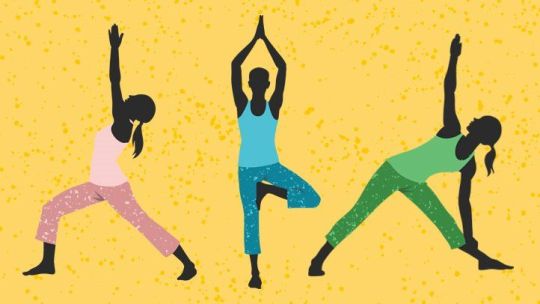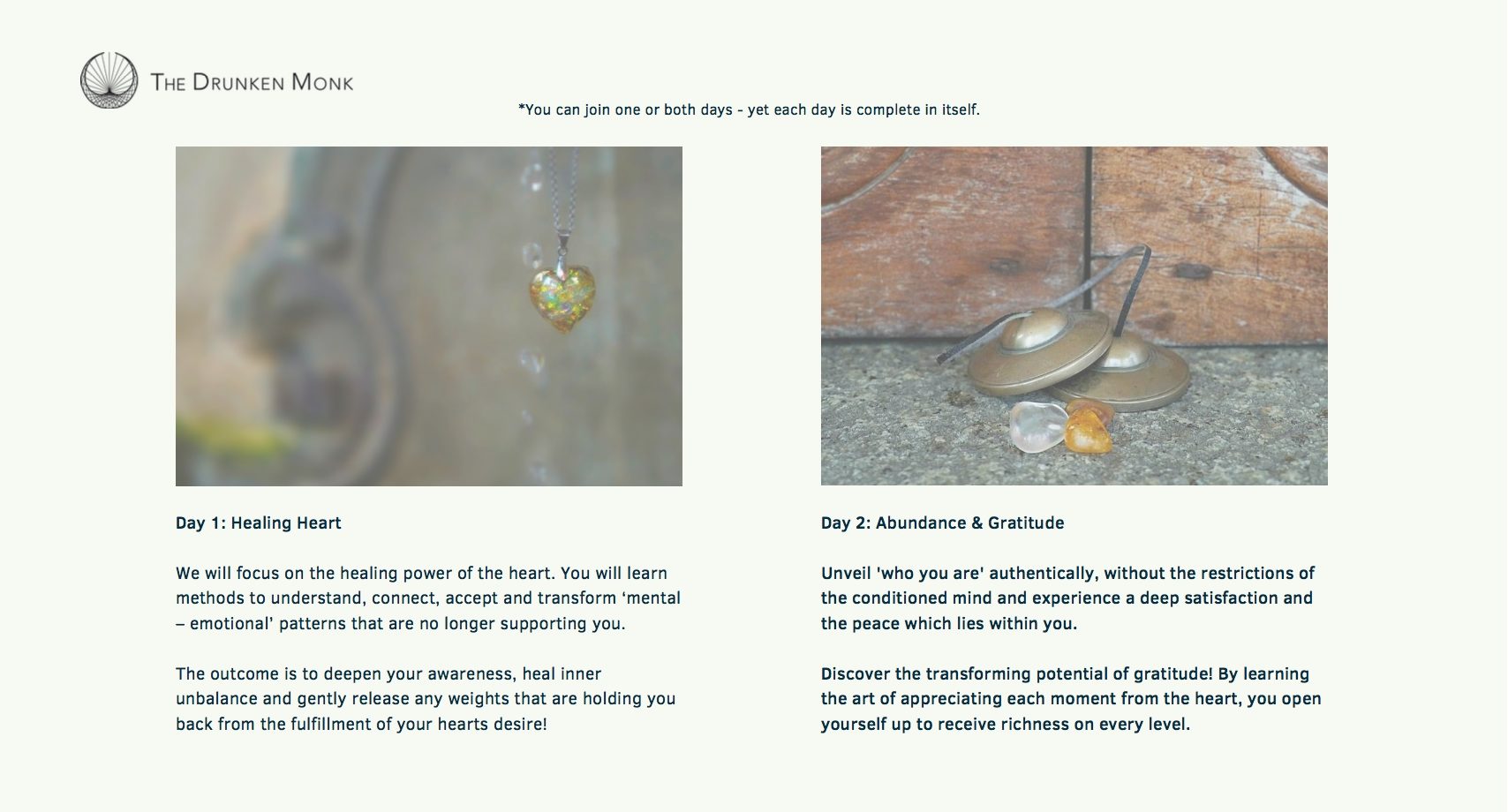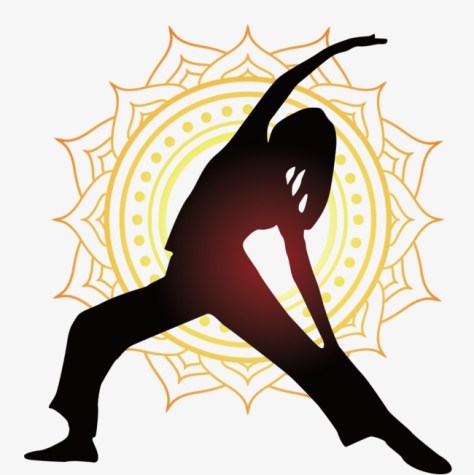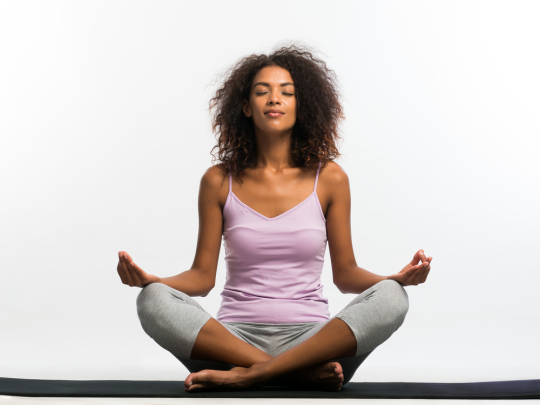#whatsnew

If you’re suffering from chronic stress, you may want to learn how yoga can help you feel better. According to research, yoga improves the functioning of the autonomic nervous system, which is responsible for regulating many aspects of the body’s health. It helps the body combat stress by strengthening the parasympathetic nervous system, which inhibits the high energy functions of the sympathetic nervous system. Yoga has a number of other benefits, including improved heart rate and relaxation.
Many benefits of yoga are self-evident. Most people experience some level of stress on a daily basis. Some of it is mild, while other times it’s unbearable. But regardless of the severity of your stress levels, finding ways to manage it is important. One of the most effective techniques is yoga. It is a natural stress reliever that helps people of all ages reduce the stress they experience every day.
As we all know, life is full of stressful events, but you can control the level of stress in your life by practicing yoga. In addition to relieving stress on the mat, it can improve your mental state. By focusing on breathing, yoga helps you to become more connected with your body, reduce your stress levels, and develop positive mental patterns. While practicing yoga, you will find that you’ll be less stressed and will feel more calm afterward.
A few basic yoga poses are helpful for helping you reduce stress. Some of them include the forward fold, which allows you to tune out the outside world and feel quiet and peaceful. It is also beneficial to learn how to regulate your breath before doing yoga. Once you’ve mastered the art of breathing correctly, you can try these poses to help you deal with your stress levels. You may even notice that you can manage your stress in an entirely different way.
Practicing yoga allows you to slow down, which is a great way to cope with the stresses of modern life. It improves your breathing capacity and releases feel-good hormones, which helps you feel better. By increasing your body’s efficiency, yoga also reduces the risk of depression and anxiety. The benefits of yoga extend to your mental and physical well-being. If you’re unsure of how yoga can help you, consider getting started today.
The basic yoga poses can help you deal with a variety of conditions, from headaches to low back pain. Because yoga stretches these problem areas, it releases the tension and pain associated with those conditions. The mind is constantly active, racing from one thought to another, ruminating on past events. This constant work is exhausting and stressful. A yoga practice helps you take a break from this and many other issues in your life.
One of the best poses for dealing with stress is the bridge pose. This is a seated position that makes a bridge between your head and your feet. Bridge poses are therapeutic and lower blood pressure. Bridge poses are effective at relieving anxiety, headaches, and fatigue. Try the bridge pose for 3-5 minutes. You will notice an increase in energy and a reduced sense of stress after completing the bridge pose. This pose can also improve your mental focus and endurance.
https://yogainhiplaces.com/how-yoga-helps-to-reduce-stress-3/
Thus, the Bhashya (commentary) gives the context, the meaning of the Sutra, and the meaning of the whole set of Sutras.
Vyasa Bhashya on Patanjali Yogasutra
The Yoga Sutras of Patanjali are generally understood with the Bhashya written by Vyasa. According to some scholars, Vyasa’s commentary was written between the 4th and 5th centuries AD.
Some scholars attribute the commentary work to Vyasa, who wrote Mahabharata. This iconic sage Badarayana Vyasa has written the Bhashya in the Yoga Sutras of Patanjali.
However, some people attribute the comment to Patanjali himself. According to them, after writing the Sutras, Patanjali explained the Sutras with his Bhashya, as this was a popular way of writing the explanation during the Patanjali period.

Traditional study of yoga sutras
The Pada-Vakya-Pramana Shastra should be studied as these are the basics. Pada refers to Sanskrit grammar. Vakya refers to Purva Mimamsa, and Pramana is the Tarka / Indian logic. These prepare you to understand how Sanskrit texts are written.
After that, with sufficient knowledge of Sanskrit literature, one must stop at the study of the Yoga Sutras with the support of Vyasa’s commentary. To deepen your understanding of Yoga Sutras, you should also study other comments on Yoga Sutras after thoroughly studying Vyasa’s comments.
Other comments on Yoga Sutras are:
Bhoja Raja’s Raja Martanda | (written mainly in the 11th century)
Bhikshu’s Vijnana Yoga Bhashya Vartika
Ramananda Saraswathi Yoga Mani Prabha
Sometimes we include links to online retail stores. If you click on one and make a purchase we may receive a small commission.
Source link
https://yogainhiplaces.com/patanjali-yogasutra-traditional-way-of-studying-yoga-sutra/

You may be wondering, Will Meditation Help Me Lose Weight? While the benefits of meditation are numerous, you should understand that there are some drawbacks to it as well. As with any weight loss method, it takes dedication and practice to achieve the best results. If you are unsure if meditation is right for you, try it for at least a week to see if it can help you lose weight. After a week or two, you should see significant results.
When used correctly, meditation can help you lose weight by reducing stress. Studies have shown that stress is one of the primary triggers of weight gain and loss, and dieting does not address it. Stress causes hormones to be released that help our bodies store fat. Practicing meditation can help you break this vicious cycle. The benefits of meditation include reducing anxiety, lowering stress hormone levels, and improving your overall well-being.
In addition to helping you control your thoughts, meditation helps you make better decisions about your diet and exercise. It can reduce stress and make you more likely to follow through on a new regime. Meditation can help you stick to the program for a long time. By learning how to meditate, you can create a lasting habit with a diet and exercise routine. As long as you don’t bring any major expectations to your meditation, you’ll be successful!
The first thing to remember when you start meditating is to remember that you’re not your thoughts. Just notice them and ask yourself, “Why do I want that?” Then, you’ll discover your self-defeating patterns and develop compassion for yourself. Once you reach this place, your body will begin to reveal its own health instincts, which will often result in effortless weight loss. In addition, meditation can make you more aware of the feelings and sensations that your body is letting you feel.
While meditation doesn’t guarantee weight loss, it can help you create better habits and curb emotional eating. Ultimately, it’s an exercise for your mind and body, and is free. Try a meditation session if you’d like to learn to meditate and reduce stress. It’s free, and there are no side effects! When you meditate, you quiet your mind and breathe deeply. You can try various meditation techniques until you find one that works for you.
There are numerous benefits of meditation for weight loss, including improved mental clarity and stress control. It can also reduce the inflammation response that contributes to unhealthy eating habits. According to Dr. Adam Perlman, executive director of Duke Integrative Medicine, it can also help you become more aware of your eating habits. Regular meditation also helps you manage your emotions and feelings. By doing this, you’ll be more likely to maintain a healthy weight.
https://yogainhiplaces.com/will-meditation-help-me-lose-weight-3/

The Hindu reformer Swami Vivekananda brought yoga to a wider audience. He toured the United States to raise money for India’s poor and gave eloquent speeches at the first World Parliament of Religions, an interfaith conference. The popularity of yoga spread around the world, and he began to tour the United States, revitalizing the practice of Patanjali. By the 1930s, his teachings had become popular worldwide and were broadcast worldwide.
Krishnamacharya is considered the founder of yoga, but many other people claim to be its inventor. Krishnamacharya’s first disciples included Hollywood stars. Yoga soon became a staple in the American popular culture, and Richard Hittleman’s 1960 book, “Yoga and Health,” led to the first television series dedicated to the practice. Bikram Choudhury was another influential figure in yoga’s evolution. These men, along with Krishnamacharya, taught the exercise to a broad spectrum of people.
In 1924, the United States Bureau of Immigration imposed quotas on immigrants from India. This forced Indian yogis to migrate to the East. A few years later, in 1947, Theos Bernard published Hatha Yoga: The Report of a Personal Experience, which has become one of the most important texts for the practice today. His work also inspired a plethora of associations. The story of yoga continues to unfold today, and many of the earliest teachers are remembered by many students as inspiration.
The practice of yoga dates back thousands of years. The Vedas, which were composed during the Shrutikal period, mention yoga numerous times. Some believe Adinath Lord Shiva was the first representative of Hatha-yoga, but this is not true. Many yogis of the ancient world regarded Adinath Lord Shiva as a representative of the Hatha-yoga tradition. Nevertheless, yoga began centuries ago, and was documented in the Yoga Sutras.
There are many theories about the origins of yoga, and the great sages of India changed the course of yoga and introduced it to the West. It has since spread to the rest of the world. And as we all know, there are many myths about how Yoga got started. So, how did it come to be? What were its benefits? And what did it mean for the world? And who were its greatest practitioners? You can find out by reading about the founders of yoga.
Hatha yoga originated in India around 500 AD. It focuses on purifying the mind and body. Through cleansing the mind and body, practitioners can reach the highest levels of practice and achieve samadhi. Thousands of yogis followed Patanjali and influenced the western world profoundly. Over time, the practice of yoga gained a place in society as a secular spiritual practice. And its popularity has only grown.
Swami Vishnudevananda adapted yoga to accommodate modern lifestyles. The modern approach to yoga emphasizes proper exercise, breathing, and relaxation, as well as vegetarian eating. In addition, the Upanishads delve on the philosophy of yoga and meditation. And he even includes mantras to meditate on. There are so many traditions that yoga is a worldwide phenomenon. If you are curious about its origins, here is a short history of its most famous founders.
TREASURES OF YOUR HEART (2x workshops in Zurich, Air Yoga)
Dates: 18 and 19/6 of 2022
In this flowering season, embark on a wonderful journey to release the healing and transforming treasures of your heart.
Pere has prepared a beautiful collection of conscious disciplines such as guided meditations, conscious movement, AUM voice, heart expansion, zen self-research and sharing circles to reveal the transforming power of the heart and release the unique “fragrance’.
To support this smooth but powerful process, these will be some of the basic sessions enhanced with charming poems by the Sufi master and poet Rumi. The magic of his poetry is that his words speak directly to our hearts. Reading Rumi’s words we are directly experiencing the message she is sharing.
Connect with your true self, free from the constructions of social conditioning. Experience the natural waves of love, inspiration, joy, and peace within you.
Learn to break free from the limitations of internal patterns and develop skills to transform the energy of inertia into a healthy flow. Learn how a state of deep gratitude draws abundance into your life. Clean up the past and create the space to unite with your sense of life and purpose.
These workshops will be divided into two parts, but each day is complete on its own and you can attend one or both days.

Peter Harper is an experienced spiritual guide with 40 years of experience in self-knowledge and spiritual guidance. He has devoted many years of research to distilling a deep understanding of the transformation process. As a result, he has developed modern accessible techniques that can be applied by both beginner and advanced students. In addition to face-to-face and online workshops, Peter produces conscious music and audio in his recording studio, as tools to support the awakening process.
Peter is the founder of the drunken monk project, which connects spirituality with everyday life. The project offers guidance for both companies and individuals by providing a practical and grounded experience of spiritual awakening to the demands of modern life.
Peters ’intention is to create an experience of gentle love and healing for the participants, while being transformative and profound. You can find more details about Peter, social links and his work at https://thedrunkenmonk.org.
"Above the clouds of the mind, there is a clear blue sky. I will find you there …”
Peter Harper
Peter Harper will offer his workshops on Saturday 18 June and Sunday 19 June 2022 at AIRYOGA, Fabrikstrasse 10 at 8005 Zurich.
Saturday, June 18, 2022 from 2:00 pm to 5:00 pm (Session 1): Healing Heart
We will focus on the healing power of the heart. Here you will learn methods to understand, connect, accept, and transform “mental-emotional” patterns that no longer support you.
The result is a deepening of your consciousness, healing your inner imbalance, and gently releasing any weight that prevents you from fulfilling your heart’s desire.
Sunday, June 19, 2022 from 2:00 PM to 5:00 PM (Session 2): Abundance and Gratitude
Reveal “who you are” in an authentic way, without the constraints of the conditioned mind, and experience deep satisfaction and the peace that lies within you.
Discover the transformative potential of gratitude. Learning the art of appreciating every moment from the heart, you open yourself to receive wealth at all levels.
Download the brochure and calendar of these workshops:
AIR-YOGA-treasures-of-your-heart.workshop.pdf (24 downloads)

No prior knowledge of Yoga or meditation is required to join these workshops.
Peter teaches in English.
The rate is Fr. 90.- per session, or Fr. 160.- for both sessions.
The number of participants is limited.
Covid protection measures and regulations in force at the time of the workshop apply.
Please note the booking policy and workshop cancellations a AIRYOGA.
Contact for more information [email protected]
Sometimes we include links to online retail stores. If you click on one and make a purchase we may receive a small commission.
Source link
https://yogainhiplaces.com/treasures-of-your-heart-2x-workshops-in-zurich/

Can Yoga Be Done During Periods? Yes! Yoga for period cramps focuses on gentle movements and energy conservation during your menstrual cycle. Most poses are performed in a seated position to protect your lower body from the cramping caused by your period. You can perform these poses easily at home, without the need to visit a yoga studio. If you’re worried about your period or are not sure how to do yoga during your period, here are some tips for doing yoga while on your period.
If you’re unsure whether yoga is safe for your body during your period, consult your doctor. You’ll want to avoid doing inversions and other poses that could disrupt the downward flow of blood from the uterus. Similarly, yoga poses that put pressure on your pelvic area are generally not recommended for women who are recovering from an injury. If you’re unsure, you can try the Goddess Pose instead.
Apart from relieving pain and discomfort, yoga for period problems can help you improve your mood and regulate your cycle. Gentle yoga poses will help you open your pelvis and relieve pressure. It will help you control your emotions and cope with mood swings, anxiety and frustration. The benefits of yoga for period pain are many and can be felt immediately. And they’re also a great way to stay healthy! You can even start a new yoga practice during your period.
Some of the most popular yoga poses for period pain include the Seated Forward Bend and the Corpse Pose. Both of these poses stretch your hamstrings and inner thighs and improve your digestion. They also help reduce menstrual pain and reduce headaches and fatigue. Try these poses during your period to keep your body and mind in alignment. Just be aware of your period and stay as relaxed as possible. Soap up some relaxation in the sun salutation, seated forward bend, or corpse pose.
Can Yoga Be Done During Periods? The answer is yes, but it depends on what style you practice. Some women practice intensively while on their period while others slow down their practices. Choosing the right style for your body is a personal choice and can change from month to month. For example, one woman might practice yoga during her period but stop it altogether while another might continue her routine with a lighter, more restful style. The same applies to yoga for period pain: it is a personal choice!
Although menstruation is a natural part of women’s lives, it is a good idea to avoid inversions and other dangerous poses while on your period. These poses reverse the normal flow of prana (life force energy) through the body. As such, you risk disrupting your menstrual cycle and causing yourself problems later on. If you are unsure about whether or not yoga is safe, consider asking a yoga teacher.
https://yogainhiplaces.com/can-yoga-be-done-during-periods-3/
In the last 15 months, I have given over 700 hours of online training. Prior to that, I taught continuing education for over 10 years.
I was really surprised to find that online training has not only been successful, but also has some different advantages over in-person training. (Full disclosure: In 2022, I intend to offer a hybrid TT in London. I will also continue to offer full training online only.)
The truth is that when online training is taught according to best practices, they not only meet the quality of face-to-face training - they pass it on.. You may not know that Stanford, MIT, Duke and Harvard offer online courses and degrees - the yoga community is finally catching up!
And don’t get me wrong: the 56 most recent reviews of 500-hour certified graduates doing this course online gave the training a 10 out of 10 rating in Yoga Alliance. (Review number 57 gave it a 9 out of 10).
What makes this online training unique and perhaps even more desirable to you than face-to-face training?
1. It’s easier to fit it into the logistics of modern life
➡ Do you have to take several weeks off a year to leave your family or pets? No.
➡ Do you have to stop working and lose income? Not again.
➡ Do you have to keep your regular students high and dry while you continue your studies? Unless you want to!
2. It is more profitable
Unless you live nearby, face-to-face training requires travel expenses, housing costs, eating out, and the added stress of losing income while studying. For online training, this means that you pay 50-60% less than the total costs of face-to-face training.
3. You have more time (much more!) To absorb the content
In terms of content itself, the superior e-learning experience can be summed up in three words: Pause, rewind, and look again.
The truth is that you will be saturated during face-to-face training. There is only so much that you can absorb in 8-10 hours a day.
When you train online, you can take breaks. You can rewind if you didn’t understand something, and then go live Zoom calls with prepared questions.
You can re-practice to teach inspiration and reinforce what you have just learned.
The bottom line is that you have six months to learn, digest, and integrate each module in just 12 days.. This added time gives you a lot of flexibility; it allows you to adapt the experience to your life and your learning style.
If there’s still an unanswered question or something else that’s holding you back, you can email me!
More information here.
Sometimes we include links to online retail stores. If you click on one and make a purchase we may receive a small commission.
Source link
https://yogainhiplaces.com/can-online-yoga-teacher-training-be-better-than-in-person-training/
Guilt is a strong feeling of anguish about your words, actions, feelings, and thoughts. Research shows many signs of guilt: insomnia, sadness, anxiety, low self-esteem, emotional numbness, self-sabotage, recurring obsessive thoughts, anedonia, and a disconnected feeling from your purpose. People are prone to mistakes. Therefore, it is important to learn to overcome guilt. According to scientific research, guilt can cause many physical and emotional disorders. Criticism and self-judgment are two aspects that trigger recurring memories of what happened. In some cases, you may be afraid that your trusted friends or colleagues will find out the truth. Guilt can help you to acknowledge your wrongdoing and improve your behavior. However, guilt can promote positive growth or slow you down. If you have difficulty recognizing your mistakes, regular journaling and mindfulness meditation can make a big difference. Here are some tips on how to overcome guilt.
13 ways to let go of guilt
1. Learn from the past


It is impossible to correct all situations, and some mistakes can ruin your relationship. For example, a combination of guilt and sadness for something or someone you have missed may seem impossible to escape, but this is not the case. To escape a sad past, one must accept the situation. Ruminating and looking back will not fix your past mistakes unless you are ready to accept and move on with life. Here are some things to help you learn and avoid a similar mistake in the future:
- What inspired you to make the mistake? Identify the triggers that triggered your feelings and actions.
- What do your actions tell you and others about you?
- You have a chance, what would you do differently?
2. Apologize and make amendments
Apologizing for your wrongdoing can help you repair your emotional damage. A sincere apology conveys remorse and remorse to the person you have hurt. This shows that you plan to avoid a similar mistake in the future. You may not receive forgiveness at some point because some apologies do not build a broken trust. A sincere apology will help you to overcome the situation because you have expressed your feelings correctly. Also, apologizing to someone who has hurt you shows that you are responsible for your mistakes. To sincerely and effectively apologize, you must:
- Apologize
- Shows remorse
- Recognize your role
- Avoid making excuses
Making the amendments shows that you are ready to change. For example, if you can’t support your friends or spend quality time with your loved ones, you should show a desire to change. Also, if you can’t apologize directly, you can commit and write a letter. Make sure you commit to self-friendliness when making amendments.
3. Identify the source of the guilt
To overcome guilt, you should explore its source. Sometimes feeling guilty can be normal, especially if you are aware of the wrongdoing. On the other hand, you may be guilty of something that has nothing to do with it. It is important to be responsible and accountable for your mistakes. Blaming yourself for things you can’t control can ruin your life. Therefore, you should analyze and evaluate the situation to develop the root cause of the problem. Keep in mind that sometimes you may feel guilty about something you can’t blame yourself for. For example, you may feel guilty about breaking up with your loved one. Other causes of guilt include the following:
- Physical or mental health problems
- Survive a disaster or trauma
- Conflict between personal choices and values you have made
In some cases, you may feel guilty about focusing more on yourself than others.
4. Replace negative self-talk with self-compassion


As we said before, everyone makes mistakes. Therefore, a mistake does not turn an individual into a bad person. Some studies show that guilt can lead to self-criticism. Criticizing yourself will not change or improve your current feelings. Self-punishment plays an important role in impairing your emotional well-being. Instead of criticizing yourself, think about what you would say to a friend in a similar situation. Mostly, you will try to point out as many positive things as possible. For example, you can remind your friends or colleagues of their strengths. This shows that you need the same kindness when you make a mistake. Remember your value. This will play an important role in increasing your confidence in dealing with a difficult situation.
You can practice self-compassion with a little meditation. Declutter The Mind is a free guided meditation aid with practices on how to overcome guilt as well as practice self-compassion.

Free meditation appDeclutter The Mind is an application that will teach you to meditate, help you acquire the habit of a common practice and expand your mind to the teachings of mindfulness.
5. Practice gratitude
At some point in life, you may need help, especially when dealing with health problems, challenges, and emotional distress. If your classmates or friends need emotional support, you would be prepared to introduce yourself and support them. This shows that you are committed to helping them overcome guilt. In the same case, you need to ask for help if you need it. There is nothing wrong with asking for help. Also, cultivate gratitude in the following ways:
- Recognizes all the opportunities obtained
- Thank you to your loved ones for their physical, mental, and emotional support
- Always ask for help
- Make your appreciation clear
6. Forgive yourself
Self-forgiveness is a crucial aspect of self-compassion. Forgiving yourself shows that you recognize your mistakes, that you are ready to start letting go, and that you are ready to change your ways. Focus on your future without letting a past situation define you. Accepting that you are imperfect is a good way to show kindness and love. Self-forgiveness incorporates several aspects:
- Repair the damage caused
- Be more responsible
- Practice self-confidence and acceptance
- Express remorse and remorse
Forgiving yourself will help you see things from a positive perspective.
7. Talk to a professional therapist
Overcoming persistent or severe guilt requires time, effort, and commitment. Some people are unproductive when it comes to trauma, intrusive thoughts, or depression. It’s not easy to open up to someone if you fear judgment. In the long run, guilt can stress your daily life or affect your relationship. In addition, persistent guilt can cause serious mental health problems and substance abuse. Therefore, you should consider trying to find a professional therapist to help you overcome severe guilt. A reliable therapist must be reliable, affordable, reputable and experienced. A reputable therapist will give you tips and strategies for dealing with guilt. Finally, the therapist will use an approach that will help you overcome guilt in a short period of time.
8. Talk to trusted friends or family


It’s not easy to talk about a mistake you regret. This is the main reason why most people have difficulty talking about guilt, which is understandable. Isolating yourself at night prevents you from being judged. From research, isolation and loneliness can reduce your chances of overcoming guilt. There are some friends and family who can help you deal with guilt. These friends will help you with emotional support. Make sure you share your problem with someone who can keep it a secret from someone who talks to you. A trusted person will offer compassion and kindness. Sharing your mistakes with the right people will help relieve stress. Most people have gone through the same challenge; they will help you overcome guilt.
9. Set boundaries
Sometimes guilt can come as a result of unclear boundaries. For example, you may feel guilty about not being able to meet someone else’s needs. Therefore, you should set healthy limits that suit your tastes and preferences. Making your expectations clear is essential because it helps you identify behaviors that you will tolerate. These limits help prevent guilt, especially when dealing with others.
10. Recognize that guilt exists
There are times when guilt can remain hidden under symptoms such as insomnia and anxiety. It is difficult to determine this type of guilt, especially in the short term. Determining whether guilt is the root cause of these emotional health problems can help you cope with the problem.
11. Address mental health challenges
If past trauma and mental health conditions play a major role in your guilt, consult a trusted mental health expert. A mental health professional will offer you the best strategies to help you overcome guilt. Be sure to invest in a professional and trusted mental health specialist.
12. Increase your self-esteem


It is scientifically proven that guilt comes with shame, which can lower self-esteem. Overcoming low self-esteem can help you overcome guilt and shame. Therefore, you should learn to forgive yourself no matter what the situation or mistake. Looking down on yourself can reduce your confidence. Therefore, you will not have the ability to overcome the mistakes of the past. Self-compassion and self-esteem go hand in hand. If you want to improve your self-esteem, show kindness and compassion.
13. Do something good
Good deeds can help you deal with guilt. There are many things that can help you to stop feeling guilty: to volunteer and to help the community. Also, do something that will make you happy. Small profits can increase your confidence, helping you to cope with your mistakes.
Conclusion
Overcoming guilt plays a vital role in improving your emotional and physical well-being. It is important to note that you cannot change the past event. So it’s time to dump her and move on.
Sometimes we include links to online retail stores. If you click on one and make a purchase we may receive a small commission.
Source link
https://yogainhiplaces.com/how-to-overcome-guilt-decongest-the-mind/

Whether you’re seeking a peaceful, balanced life or want to improve your energy levels, Meditation 7 Chakras will teach you how to make the most of each of the seven major chakras. A clear, balanced aura and chakras are essential for good health, and this meditation will help you clear your aura and prepare for sleep. You can use this meditation to prepare your energy field for sleep, or you can do it right before bedtime.
The chakras are energy centers located throughout the body that influence our health, emotions, thoughts, immunity, and relationships. When these centers are open and in balance, positive energy flows throughout our bodies and forms our Aura. Various meditation techniques target different parts of these energy centers, including grounding meditation. While the grounding meditation activates the root chakra, it’s important to remember that the other seven are linked to it. This way, you can better understand the purpose of each chakra and its role in your life.
The first step in meditating on the seven chakras is to choose the right environment. Make sure you’re in a quiet place away from distractions. Wear comfortable clothes and close your eyes. Once you’ve selected a comfortable position, focus on each chakra and visualize the energy flowing through it. You may want to use color associations to guide you through each chakra. Focus on each chakra individually for a few minutes.
The seventh chakra is located between the eyebrows, and it’s a place of great spirituality. The seventh chakra can bring deep peace and calm, but it can also give you delusions of grandeur. A meditation instruction may use this imagery to help you meditate on your crown chakra. A meditation instruction may instruct you to envision a flower of light. The healing light spreads throughout your entire body. This meditation can help you achieve a state of deep inner peace.
The name of the seven chakras comes from the Sanskrit word ‘prana’, which means “life energy”. There are seven of these energy centers in the body, and they all correspond to major organs and nerve bundles. Each chakra must be balanced and free of blockages, and when these energies become blocked, they can manifest physical or emotional symptoms. The seven main chakras are located along the spine, beginning at the base and ending at the crown. Some sources say that there are as many as 114 chakras throughout the body.
During meditation, you can focus on one or all of these chakras, or you can choose to meditate on a particular one. It is important to find a quiet place to meditate in. A good place to meditate is a place that feels comfortable and relaxing. A place that is quiet and free of distractions is necessary to have a successful meditation. You can also choose to focus on specific chakras for the most results.

When Yoga Day is celebrated on June 21, the government’s enthusiasm for yoga has sparked controversy at home and abroad. Critics argue that the day is merely a means to advance a right-wing agenda. This year’s day also falls on the death anniversary of Keshav Baliram Hedgewar, founder of the Hindu right-wing organisation Rashtriya Swayamsevak Sangh.
The United Nations General Assembly proclaimed June 21 as the International Day of Yoga. The day is recognized worldwide to promote yoga as an ancient Indian practice of healthy living. Yoga, meaning unity in Sanskrit, unifies the mind and body to create harmony. The United Nations proclaimed the day in 2015. The idea was proposed by Indian Prime Minister Narendra Modi, who noted that it was the longest day of the year in the Northern Hemisphere. In addition to its international significance, June 21 has special cultural significance in many parts of the world.
While there are many different types of yoga, most are beneficial to our health and well-being. People of any age or gender can practice yoga to achieve inner peace and improve physical health. As with most physical activities, yoga doesn’t require extreme fitness levels. Those with an active lifestyle can benefit from yoga as well. Yoga also helps people overcome stress and anxiety and promotes a positive mental state. It is a great exercise to practice any time of year.
There are many reasons to celebrate yoga on June 21. As a day of peace and universal harmony, it is also an important day to honor Sadgurus. June 21 is also the day of the summer solstice, when the North Pole is tilted towards the sun, making it a transitional period for yoga. According to mythology, the first Adiyogi left India for the south during the month of Sankranti, which is approximately the same day of June. He met 7 sages on the way and came to Uttarayan in June.
Today, many nations are celebrating the benefits of yoga on the International Day of Yoga. The day is also marked by special events. Some locations have special ceremonies, while others hold a public event. People of different ages and physical fitness levels can participate in these celebrations. Whether you are a beginner or an expert, everyone can enjoy yoga. It helps reduce stress levels and improve the quality of life. The International Day of Yoga is a great way to spread the word about the importance of yoga.
Despite its widespread popularity, yoga has received criticism in India. It has been embraced in 192 of the United Nations member states, except Yemen. There are events in 251 cities across six continents. One event in New York City saw 30,000 people practice yoga in Times Square. And if that wasn’t enough, the day’s mission statement reflects its importance to India and the world. If yoga is part of your daily routine, you can find a place where you can practice it, whether it be in a cafe or a yoga class.

If you have been wondering what meditation does to your brain, you’re not alone. In fact, studies have shown that meditation has positive effects on the brain, and the benefits of meditation can be huge. Here are some of the benefits of meditation. Let’s explore these benefits to find out how it can benefit you. In short, meditation can make your life better in a variety of ways. Here are some of the benefits of meditation for the mind.
The first and most obvious benefit of meditation is that it reduces stress-induced hyperactivation of the amygdala, the area of the brain associated with fear and threat. In addition, meditations that focus on kindness alter the way we process sensory information and change our perceptual systems. Practicing kindness-based meditations improves our ability to control our thoughts, feelings, and actions. In addition, different forms of meditation alter the eight regions of the brain. For example, meditating can improve the communication between the right and left sides of the brain.
Neuroscientist Sara Lazar discovered that practicing meditation can change the structure of the brain. It has been shown that meditators’ brains have the same amount of gray matter as young people in their thirties, while maintaining healthy frontal cortex. In fact, neuroplasticity refers to the brain’s capacity to change throughout the lifespan. As a result, your habits, lifestyle, and experiences are all major factors in brain evolution.
Another benefit of meditation is that it can help you reign in wandering thoughts and focus on a task. Research has shown that meditation may also protect the brain from age-related changes. The practice of meditation preserves gray matter, the part of the brain that controls the speed of information processing, and can slow the cognitive decline that comes with aging. This can make it easier for you to manage stress and manage anxiety. Moreover, it can improve your mood and reduce the effects of stress on your mental health.
The most basic type of meditation is to focus on your breathing. It’s the easiest way to begin. Focusing on your breathing helps you distance yourself from your thoughts and create space between them. Your brain will naturally develop more regions as you practice meditation. It’s a long-term process that can benefit your life. And while practicing meditation every day can be very beneficial for you, it’s also good for you physically and mentally.
While there are countless benefits of meditation, the most popular reason for people to begin practicing it is stress reduction. However, science is now able to verify some of these benefits. Meditation works by reducing stress and nourishing the areas of the brain that are associated with well-being. It also decreases the activities of certain brain regions associated with stress and anxiety. Meditation can have profound benefits for you. It helps you relax and feel more at peace.
https://yogainhiplaces.com/what-meditation-does-to-your-brain-3/

Most people neglect yoga breathing, as positions dominate the practice. Here’s the importance of breathing in yoga and the techniques you should try.
Many people often become entangled in their busy lives, leaving them too rigid, tired, and stressed, resulting in a lower quality of life. If you are one of these people and are looking for a natural treatment for chronic fatigue for better health and well-being, yoga is a great alternative.
For most people, yoga may seem like an activity that only involves unnatural positions (asana). In reality, however, postures are only a small aspect of spiritual practice. Breathing is a critical component of yoga, and combining asana with breathing awareness (pranayama) is the key to reaping all the benefits of yoga .;
This is how pranayama and asana work hand in hand to promote better health, well-being and inner peace.
While deep breathing promotes a feeling of calm and can improve your overall health, doing so alone will not have any positive effect on your body. This is why asana or postures are essential in yoga as they allow you to be more flexible, regulating the flow of energy throughout your body. Although you can do as many yoga poses as you want, if you do not practice proper breathing, practice will not benefit your body.
Asana regulates the flow of energy, while breathing causes the movement of energy, helping your body to relax, open up to feel more and be in tune with what is happening in your body. cos. In addition to promoting relaxation, pranayama also allows you to experience your true essence. It achieves this by stimulating a transformation in your body and mind, purifying your overall well-being and letting your spirit shine.
Although pranayama is often overlooked in yoga, you will realize how much it can help you now that you know its importance. To help you achieve true nirvana with yoga, here are three transformative breathing techniques you should try.
Ujjayi Pranayama
This breathing technique is also known as victorious breathing or ocean breathing, and this traditional practice of pranayama produces soft, calming sounds similar to ocean waves. The sounds it emits favor a better relaxation response of slow breathing due to the vibrations of the larynx stimulating the sensory receptors and signaling the vagus nerve to produce a calming effect.
During any yoga pose, focus on your breathing and inhale through your nose, then slowly exhale through your mouth while making a “HA” sound. Do this a couple of times until you feel more rejuvenated.
Nadi Shodhana Pranayama
This practice is also known as alternative nasal breathing, which, as its name suggests, requires you to breathe between the left and right nostrils. According to the yogic belief, doing so unlocks and purifies your energy channels, balancing your mind and body. You can practice this breathing technique after an asana session by meditating.
Kumbhaka Pranayama
This technique is also known as breathing retention, where you need to inhale completely and hold your breath for 10 seconds, promoting a better flow of energy throughout the body. You can do this because when you inhale more and hold your breath, it can increase the pressure inside your lungs, giving them more time to expand and increase their capacity. It promotes better blood flow, making you feel more energized. You can do this after an asana session in preparation for mediation.
While doing yoga postures can provide great physical benefits, remember that yoga is more than a workout. Therefore, if you seek to reap the full benefits of the practice and rejuvenate your mind and body, practice proper breathing, promoting better overall health and well-being.
Sometimes we include links to online retail stores. If you click on one and make a purchase we may receive a small commission.
Source link
https://yogainhiplaces.com/the-importance-of-breathing-in-yoga-meditation-is-easy/
For most of us, everyday life is full and busy. And all this work can become a way of life a bit of autopilot, where we just keep moving, day after day.
And the faster we go, the more we do, the less we tend to pause and reconnect with what really matters deep in our hearts. And then it’s too easy to lose our way.
So there is a huge amount of value in making room in our lives from time to time, to take a break and check ourselves out.
Here are some tips to help you register with yourself:
You might like to meditate on it or write the answers in a diary or a voice note on the phone.
- Am I making time for the things that really matter?
- What, if anything, keeps me awake at night?
- Am I living in a way that I feel really connected to my values?
- What conversations have I been postponing that are really important?
- What decisions should be made that have not been made?
- Am I the person I want to be?
- What about something I keep in my head constantly that needs to be addressed?
- Where do I need help or support that hasn’t been communicated yet?
- What could be improved in my relationships? What can I do to make this happen?
* To get the most out of this practice, check to see if you can occupy a quiet space of the day (the best would be 30 minutes or more) to allow the most authentic answers to come from the bottom of your heart and intestines instead of only the initial superficial answers that may come directly to the head.

While we may think we are too busy to take time to pause and reflect, when we do, we let go of all distractions, reconnect with our heart and wisdom, and make sure we don’t fall for each other. once again. of course of the life that is faithful to us.
Then we can use this information to guide us down the path we take. We can let go of some things that are not essential or that are not aligned with who we are and we can start spending our time prioritizing the things that matter most.
By doing regular checks like this we can grow in self-knowledge and wisdom and continue to adjust our inner compass to the true north and to a life full of meaning, purpose, connection and fulfillment.
I wish you all the best with this practice and, as always, thank you for your practice and your presence here in this community.
Lots of love, Melli
Photo ofMitchell HartleyactivatedSplash
Sometimes we include links to online retail stores. If you click on one and make a purchase we may receive a small commission.
Source link

If you’re curious about how much meditation is beneficial, read on. It might surprise you to learn that meditating even just once a day can be very beneficial. There are many benefits of meditation, including an increase in overall health and relationships, a reduced risk of chronic conditions, and a reduction in depression symptoms. Here are some of the most compelling reasons why meditation should be part of your daily routine. Once you understand the benefits of meditation, you’ll be well on your way to a more stress-free life!
The benefits of meditation go beyond the obvious: it can improve your relationships, reduce stress, and enhance your ability to observe. Research has shown that meditation improves your ability to empathize, reduces your risk of depression, and can increase your creativity. These benefits can be seen in just a few weeks of regular meditation. The benefits of meditation are so numerous, you might be wondering how much you should be doing. Thankfully, meditation is a proven way to improve your life and improve your relationships.
Even if you only meditate for 10 minutes a day, it can help you. While 10 minutes is a good start, you can always work your way up to 20 minutes. Whatever your level of meditation, it’s important to track your progress and make sure you do it at least once a day. It will keep you accountable for making the time to meditate. So, start by meditating and be consistent with it! If you feel a sense of accomplishment after meditating just once, start by adding another 10 minutes to your daily routine.
Whether you meditate for an hour or two, it is important to know how much time you need to meditate for optimal results. While there are many types of meditation, some of the most popular practices are body scan, loving-kindness, and observing-thought meditation. Meditation is beneficial to people of all ages and backgrounds. It helps you stay focused on your daily activities and improves your health. Fortunately, you can find a meditation program that works for you. You may even be pleasantly surprised by what it can do for you.
Many people find that 10 minutes a day can help them feel calmer. A recent study found that people who meditated for 13 minutes per day for eight weeks had improved attention, working memory, and recognition memory. These results are more significant than those of people who meditate for just four weeks. However, the consensus among experts seems to be 10 minutes a day. Everyone’s body responds differently to this amount of meditation.
In addition to reducing psychological stress, studies show that meditation can reduce physical pain and improve sleep. Meditation is about accepting the way things are and letting go through a disciplined practice of the mind. It helps people with anxiety, which can lead to sleep disorders and irritability. In addition to being physically taxing, unproductive worries are a pattern that can be extremely stressful. Therefore, the most important benefit of meditation is to reduce the anxiety level and anxiety.
https://yogainhiplaces.com/how-much-meditation-is-beneficial/

In the modern world, we often find ourselves in situations where stress can take control of our mind and body, affecting our mood, well-being, and interactions with others. Whether you live in a relatively relaxed and stress-free lifestyle or find that stress negatively affects your day-to-day life, we will all come to a point in our lives when we need to learn to understand and manage stress. ‘Stress.
There have been numerous studies on the effect that listening to music can have on both stress levels and mood. This research has routinely supported the incredibly positive change that can be achieved when incorporating music listening into various daily activities, as well as some more difficult unusual tasks.
What genre should I listen to?
Of course, not all musical genres will have the same emotional effect on individual listeners. Factors such as music genre preference and the listener’s current mood will affect how the music is received. However, it has been suggested that stress levels can still be reduced even if you don’t particularly like the music you’re listening to. For example, you may not be a big fan of heavy metal, but listening in a stressful situation could still help reduce your overall stress levels.
Jazz and classical music are said to be most effective in reducing stress levels, improving mood, and even increasing brain function. Cortisol is a stress hormone released in the body to help cope with a stressful situation. For example, in history, stress was more likely to come from escaping a predator. This stress hormone tells your body to send more energy to your muscles to help you run faster. Now, it’s not too often in modern times that we find ourselves running away from predators, but the same theory still applies. Research has shown that classical music can effectively reduce levels of stress hormones such as cortisone and cortisol. You may also like to know that not only classical music can have a positive effect on your sleep. Marconi Union’s “Weightless” is said to be one of the most relaxing songs ever created.
How it works?
There are many reasons why listening to music can help reduce stress levels and improve mood. Perhaps most obvious is its ability to drown out the irritating noises, distractions, or negativity surrounding it. Just putting on headphones and pressing play can help you focus and keep you from being distracted by the conversations around you, for example.
Have you ever felt the need to drive fast while listening to loud music in your car? This is a good example of how music can provoke certain emotions and reactions in the human body. Observed with an increase in heart rate and blood pressure, fast music at 120-130 beats per minute can increase anxiety. Now let’s think about the opposite scenario … low-paced music at about 50-60 beats per minute can only lower your heart rate and blood pressure. Low-pitched music that incorporates softly rounded melodies along with elements of nature such as rain, birds or waves can have even more impact, helping to slow down breathing and reduce the release of these dreaded stress hormones. .
How does music help during meditation?
Closing the distractions around you and focusing on breathing can be a challenge if you may find yourself in a noisy or busy environment. During meditation, listening to music can help you avoid these irritating distractions. When you listen to music during meditation, many discover that the endless talk that usually takes place inside the brain will begin to fade and you can get thoughtless, approaching, in turn, the meditative state you want to reach. While music can be an amazing aid for all levels, it can be especially helpful for those who are new to meditation and need a little extra help when trying to concentrate.
As we said before, you should find your preference when it comes to meditation music. Of course, there are some types of music that are commonly used for meditation, such as instrumental tracks, chants, and ambient noise, including the sounds of rain and waterfall. If you are new to meditation, you may find yourself thinking too much about music. You should try to focus on the feelings in your body that evoke the music instead of the music itself.
According to Google trends, there has been a significant increase in the number of people seeking meditation music since the early 2000’s and rightly so. With a combination of increased educational resources on the benefits of meditation along with just about any music you want to be available online, sites like youtube have become great platforms for a perfect meditation playlist.
How else can music benefit me?
While stress reduction has been the focus of many studies and research in recent years, there are other benefits that music can have on both the body and the mind.
Improves exercise - It has been shown that listening to music while exercising can promote incredible improvements not only in mental but also physical stimulation. This in turn increases overall performance. Music has also been shown to be a great motivator when it comes to aerobic exercise.
Relieves pain and promotes healing Similar to meditation, listening to music can be a great tool when it comes to injury recovery or surgery. Many studies have shown that patients who incorporated music into their care program felt less pain and had a more positive recovery process.
Improves memory Listening to music has proven to be not only an incredibly effective way to prevent memory loss, but also a tool to recover lost memories. The melody and rhythm of music can help our brain create patterns that in turn improve memory and memory retention.
Improved intimacy and relationships - When used in conjunction with meditation, listening to music can promote improvements not only in your relationships with friends, family, colleagues, and partners, but can also help improve intimacy. Music and meditation together can help you understand, recognize, and deal with the emotions you have been struggling with.
Improves eating habits - It may be surprising to know that listening to music and meditating can really have a positive impact on eating habits. It is known that emotions such as sadness and conditions such as depression can encourage overeating or comforting eating. Meditation and music can help you manage these emotions without the help of food. Music can also help you relax while eating, lowering your heart rate and, in turn, the speed at which you eat. This is likely to make you fuller faster and therefore eat less.
Improves sleep - The parasympathetic nervous system affects the way we relax and prepare for sleep. Studies have shown that this system is positively affected, favoring a more restful and consistent sleep in those who listen to about 40-45 minutes of relaxing music before bed. The effectiveness of this theory really depends on the type of music you listen to.
In conclusion, whatever the activity or goal, there is no denying that music can have an incredibly positive impact on our lives when used properly. For more information, see 15 amazing ways music can affect our lives and our brains.
Sometimes we include links to online retail stores. If you click on one and make a purchase we may receive a small commission.
Source link
https://yogainhiplaces.com/how-music-can-reduce-stress-and-regulate-moods-meditation-is-easy/
 Addiction to painkillers
Addiction to painkillersLiving with painkiller addiction can cause a variety of physical, mental, and emotional problems that aggravate the pain. Help your loved one to recover.
Painkillers are essential for keeping a variety of aches and pains at bay, from headaches to surgical wound pain. It also comes in a variety of types, depending on the intensity of the pain.
Paracetamol is often given for headaches and other non-nervous aches. There are also non-steroidal anti-inflammatory drugs (NSAIDs), such as ibuprofen and aspirin, which are used to relieve back pain and toothache. They are also used to treat arthritis inflammation, strains, sprains and more.
The most potent painkillers are opioids, such as codeine, fentanyl, and morphine. Opioids bind to specific receptors in the brain, spine, and other parts of the body to reduce the pain signals sent to the brain. It is often given to end-of-life patients, scoliosis treatment and surgery patients to help control the pain they feel for their symptoms.
Complications of misuse of painkillers
While painkillers are important types of medications, they can also be dangerous, especially NSAIDs and opioids. Excessive consumption of NSAIDs, such as ibuprofen, can lead to dangerous complications. These complications can include stomach ulcers, high blood pressure, and liver and kidney problems. And even if they are not addictive, people can develop an addiction, taking them every time they feel even the slightest pain, which can lead to overuse.
Opioids, however, can cause addiction if misused. According to the Mayo Clinic, addiction occurs when a person experiences something pleasurable and feels as if it is something without which they can no longer live. Opioids create a feeling of pleasure by releasing endorphins, neurotransmitters that make the brain feel good. They greatly increase the sensations of pleasure and dampen the sensations of pain, creating a temporary but powerful effect. When this low decreases, a person may want to hear it again as soon as possible.
Opioids also cause the body to slow down its production of endorphins, making it tolerant of the same doses of the same drug. This can lead a person to increase their dose in order to feel equal or even stronger. This puts a person on the unstable path of addiction and it is difficult to help them get out of it.
Most troubling is that anyone who uses opioids can develop an addiction. According to the Priory Group, more than 115,000 opioid prescriptions are made in the UK in one day. About five of these recipes cause death. Opioid deaths have also risen 41 percent to more than 2,000 annually.
Help a loved one who is addicted or addicted to painkillers or at risk of developing one with the following steps:
Know the symptoms
Living with an analgesic addiction has a variety of symptoms. The most obvious is the continued use of drugs even after the pain has subsided. They may also lie or exaggerate about their pain to get a prescription from a doctor. Physical and mental symptoms include excessive sweating, problems with focus, dizziness and disorientation, and more. When they are deeply in their condition, they may have trouble prioritizing their work, their loved ones, and other important responsibilities.
If you suddenly stop taking painkillers, you may experience withdrawal symptoms such as nausea, vomiting, stomach cramps and more. Knowing these symptoms will help you identify if your loved one may be living with an analgesic addiction.
Educate them about this
Do research on painkiller addiction and its effects on a person. Talk to a psychiatrist to find out. When you are sure that your loved one is living with an addiction, you can contact them. Confront them about the effect of addiction on your life. Educate them about the complications of addiction and how it harms their physical and mental health and alters their work and relationships.
Encourage them to seek help
The best way to reach your loved one is to encourage them to seek professional help. Have them work with a psychiatrist to find out which treatment method is best for their disorder. There are two categories of treatment: medication and behavioral treatment. Behavioral treatments help patients to stop using drugs by changing their unhealthy behaviors and thought patterns. Experts will help you avoid situations that can lead to a relapse and manage your cravings for pain medication.
It is important to just encourage them and not force them to receive help. You don’t want them to bother you or prevent you from being treated for a bad experience they have had with you. Getting treatment should be entirely your choice.
Painkiller addiction is likely if someone you love is taking opiates for their current condition. Use these tips to learn all you can about this and how you can help them recover while managing their pain.
Sometimes we include links to online retail stores. If you click on one and make a purchase we may receive a small commission.
Source link

According to a recent survey by the Yoga Alliance, there are now more yoga studios in the United States than at any time in history. More people are choosing to take yoga classes in the U.S. than ever before, and more people are also finding yoga classes in health clubs and fitness centers. In the survey, 70 percent of respondents cited the cleanliness of the studio as a determining factor, while only five percent cited the convenience of location. While these figures may seem small, they indicate the growing popularity of yoga.
While yoga is still relatively unknown in rural areas, it has become a growing trend in urban areas, particularly California and New York. Although women outnumber men in the United States, men are now buying Yoga clothes and joining classes. The popularity of yoga in these cities may have something to do with their low rates of commuting, but it’s easy to see that the practice has taken root in U.S. culture.
Unfortunately, the pandemic has put yoga classes on the back burner, with many studios closing because of health concerns. Lockdowns and restrictions on yoga classes have made people more interested in home yoga workouts. Once restrictions are lifted, these trends are likely to continue. However, in the meantime, some yoga studios may also shut their doors. This will depend on their financial situation and agreements with landlords and creditors. These closures, and others like them, could lead to increased demand and the loss of yoga studios.
According to the Centers for Disease Control and Prevention, there are now over 36.7 million “yogis” in the US. This is a substantial jump from the 20 million people who practiced yoga in 2012. And since 2012, this number has climbed 50%, with only two percent of them being advanced practitioners. And in fact, one in every three respondents said they were unlikely to take up the practice of yoga within the next year.
There are more than 34,000 yoga studios in the United States. According to IBISWorld, the yoga industry is worth a staggering $84 billion worldwide, with nearly half of all owners in the industry having been in business for over six years. Additionally, the growth of yoga in the US has led to an expansion of existing yoga studios. And it has been good for both the economy and community. And, as a result, more people are starting to practice yoga.
According to the survey, women are more likely to practice yoga than men. Interestingly, the most common age group of yogis is the 35-54 demographic, with people over 65 being the least likely to participate. However, it is not only the younger generations who are interested in yoga; many older people are also looking into it. And the benefits of the practice aren’t limited to those in their forties. For example, yoga has been shown to help people reduce stress and improve their performance.
https://yogainhiplaces.com/how-many-yoga-studios-are-there-in-the-us-3/
Breaking old habits is easier said than done. Here are 3 things that will help you improve and stay sober.

The road to sobriety is full of challenges. In the early stages of recovery, things often seem to move at a fast pace. Everything you’ve known so far has been turned upside down and there’s finally light at the end of the tunnel. But you shouldn’t think that your recovery is about to end. In fact, you haven’t started yet.
If you find it difficult to get sober, try to stay that way indefinitely. Many people have compared it to running an endless marathon. Of course, you have the support of your friends and family, and this can be very helpful. But recovery is a lonely path and you will experience isolation, loneliness and exhaustion. That’s why you need to be constantly on guard to monitor your impulses. Otherwise, it could fall.
Relapse is not as big a failure as people say. It is a perfectly normal part of the recovery process, and many people in drug recovery have experienced it at least once. Hours turn into days, days into months, and eventually you get to a place where you feel you can be yourself again. However, you should consider your triggers.
Putting on and staying sober is a full-time job. Here are some tips and tricks to help you reduce some of your struggles.
- You need a change of scenery
You will go through so many changes and transformations in such a short period of time. To break the vicious circle of addiction, all you need is a complete reboot. You have to get out of what you know and accept the new and the unknown. In a social, mental and physical sense, a change of scenery can allow you to break free from your habits and give yourself a chance to start over.
Of course, managing your impulses can be difficult, especially at first. But you have to surround yourself with healing energy to improve your chances of recovery. The support of your friends and family, and the healing powers of nature, can go a long way in changing your mood. Even a brisk walk through the park can give you the serenity you need.
- Find new passions
The need for stimulation drives people. While some resort to physical or mental activities to fill their time, others waste their lives on vices. Many people in recovery fall off the wagon because they have not found a new way to pass the time. If you take yourself seriously to improve, it will help you find a new passion or way out that will help you express yourself in a healthier and more meaningful way.
Take the time to explore your interests. Who knows? Maybe you can unlock some hidden passion or talent. Whether through art, science or sport, learning to improve is always a good thing. Finding a passion is not just about strengthening your mind or body. It is also about finding joy in life.
- Put yourself first
Recovery is one of the hardest things to deal with, and it doesn’t make sense to be too hard on yourself. You have to accept that there will be good days and bad days, and the key to remember is to put yourself first whenever possible. Try to eliminate all sources of negativity and stress, whether they are the people in your life, your job, or your environment.
For example, if your current job is one of your triggers, it may be wise to start looking for a new job. If you live near your old shelters, consider moving to a new area. Stay away from people who can’t respect your sobriety. Eventually, you will reach a place where you can manage better. But in the meantime, try to limit your stressors and focus on getting better.
One last word
It is not easy to overcome our problems, and we will exhaust all our concentration and energy to improve. These tips will help you stay on the path to recovery and help you find solace in the fact that you are not alone. Even when you feel isolated, always remember that people are rooting for you to succeed.
Sometimes we include links to online retail stores. If you click on one and make a purchase we may receive a small commission.
Source link
https://yogainhiplaces.com/how-to-break-your-old-habits-and-stay-sober-meditation-is-easy/

